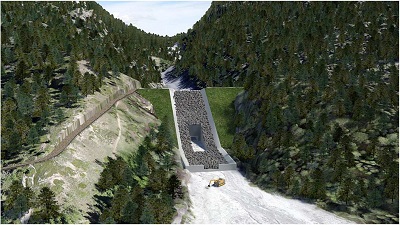 Saturday, July 27, 2024
Saturday, July 27, 2024  Saturday, July 27, 2024
Saturday, July 27, 2024 
Got news? Next submission deadline is Friday at 5:00 p.m.
Click here to submit YOUR news

A $48-million debris dam in Canmore, meant to prevent the kind of damage seen in the devastating 2013 southern Alberta floods, is set to break ground next year, an official with the mountain town said.
The structure is set to be built along the Cougar Creek, Andy Esarte, manager of engineering with the Town of Canmore said, adding that the hope is the structure will prevent major debris floods in the future.
“It depends a little bit on how the permitting process goes, but we’ll be pushing hard to be in the ground by the middle of next year,” said Esarte.
The area where the 30-metre tall structure is set to be built was once ravaged by the 2013 floods, as debris-ridden water rushed through the creek, ruining adjacent homes and shutting down the Trans-Canada Highway.
It caused extensive damage to the Cougar Creek area, decimating municipal infrastructure by washing out roads and damaging significant utilities like a high-pressure gas line as well as flooding houses in the area.
It is anticipated the new structure will be able to stop as much as 650,000 cubic metres of water and sediment.
By comparison, there were roughly 90,000 cubic metres of debris in the 2013 flood, which led to the evacuation of 1,200 residents from 300 homes near the creek.
During heavy rainfalls, the new structure is designed to direct water along with large wood and rock debris into an inundation area. The water will then be released back to the Cougar Creek downstream of the structure in a controlled manner.
“(A detailed risk assessment) showed we had a high risk of loss of life. We had a significant economic risk,” Esarte said.
“That left us looking at different structural mitigation approaches in addition to updating emergency response plans and looking at how we develop.
“Ultimately, (we) settled on the debris flood retention structure as both the most economical solution … and it also provided the highest amount of risk reduction.”
Esarte said work had been done on the area in 2012 before the town experienced a one-in-100-year flood.
Keep reading in the Calgary Herald
Watch the video and learn more about the benefits of joining Construction Links Network – the peer-to-peer network sharing platform for the construction, building and design community.
Ideal for YOUR Press Releases | Project Updates | New Appointments | Awards & Milestones | Company News | New Products/Services | Brochures | Videos | Infographics | Blog Sharing | Events and More